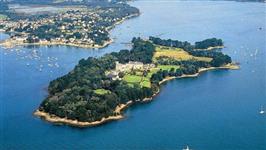ISLAND BERDER
Ile Berder is one of the most famous islands of the Gulf of Morbihan. It is possible, at low tide, to walk around in about an hour. It is beautifully wooded. We can discover a variety of Mediterranean type plant.
Berder is distinguished by his story. First of all, the etymology of his name. The first landowner known to Berder in 1713 was Miss Dubreuil-Jarno and her siblings. It is perhaps here that Berder receives his name since Berder, in old Breton "Berdic" translates by brothers and sisters of the same family. This remains an unconfirmed hypothesis.
Around 1860 the Countess and Count Arthur Mane Dillon bought the island. The Count, a French politician born in Paris in 1834 and died in Berder in 1922, was a close friend of General Boulanger, protester of the regime of the time ... He was condemned to the perpetual deportation in a fortified enclosure and was amnestied in 1895.
At that time the island was planted with only a few pines and apple trees. The small low house extended by a few outbuildings that can still be seen to the left of the main building was the only dwelling on the island.
On his return to Berder Island, the Count undertook the construction of a comfortable residence and outbuildings in the quarry west of the island, which he had opened and from which all the stone for the work was drawn.
Large lobby, gallery offices, dining room, billiard room, many bedrooms, five baths, nothing of the possible comforts of the time had been overlooked. The Count even had a Morse telegraph in his office.
A little farther on the island, to meet the artistic tastes of his wife, the Count built an original building with no particular beauty, with a five-storey hexagonal tower. On its terrace it offered visitors a magnificent panorama of the Gulf of Morbihan, which is the highest point of view.
He arranged a workshop called "the room of photography". Here were often painters and sculptors. Not far from the tower, outbuildings and sheds for a dozen cars, stables, a carousel marked in bas-reliefs of the escutcheons of the family Dillon, allowed the training of a dozen horses that could be admired from a Tribune. At the northeastern point, St. Anne's Chapel was erected in 1865 for the marriage of the son Dillon. This graceful building still houses the bodies of the Count and Countess.
And the island was transformed into a pretty park. The thorny ajones took place and trees and shrubs of all kinds.
The very mild climate allowed to acclimatize palms and resinous trees, olive trees and especially mimosas in large numbers, which does not give me its Mediterranean coast. Dillon has for a long time nourished an ambitious design for Gulf tourism development. His project did not see the light of day, but he left his mark on Larmor-Baden, which owes him a big jetty.
After being sold to the Duchess of Uzes in 1920 by a penniless Earl Dillon, it was later taken over by Oblate monks and then by the Little Sisters of Île-aux-Moines.










